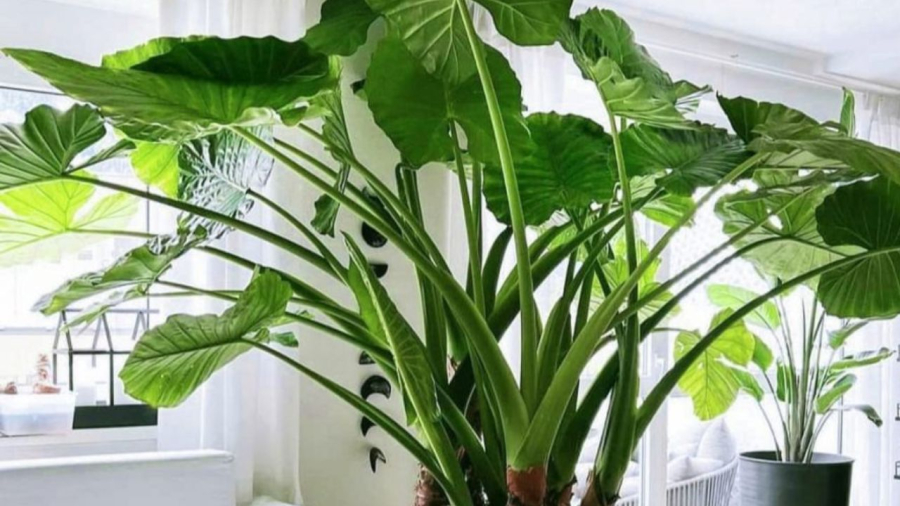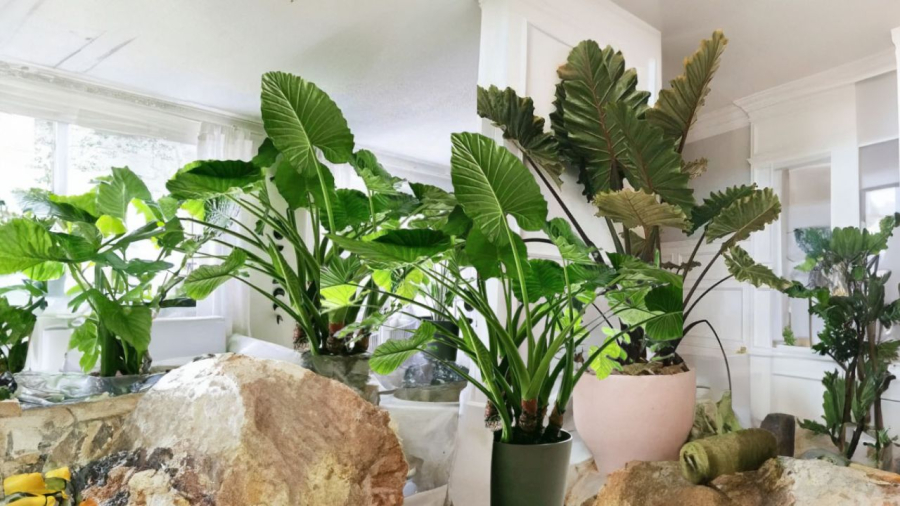The Alocasia plant, commonly known as the elephant ear, is a wild plant that used to grow abundantly in the countryside of Vietnam. Alocasia plants boast large, lush green leaves all year round. In feng shui, the Alocasia is considered a lucky plant due to its large leaves, which are believed to possess a powerful energy. The vibrant green color and the size of its leaves make it a striking focal point in any home. Additionally, the Alocasia’s large stature adds a sense of grandeur to a space.
Alocasia plants are actually wild taro plants with a large, robust stature. As they thrive in tropical regions, they are well-suited to Vietnam’s climate.
What is the significance of growing Alocasia plants?
Placing potted Alocasia plants indoors or using them to decorate walls, corners of cafes, or villas is a common practice these days. The lush green leaves of the Alocasia are believed to attract wealth and prosperity. The large leaves symbolize abundance and the containment of wealth. The larger and greener the leaves, the more vibrant and fortunate the plant is considered, bringing prosperity to the homeowner.

Alocasia Plants Bring Wealth
The size of the Alocasia’s leaves indicates a healthy and favorable living environment. According to feng shui principles, the vibrant green and bushy leaves represent prosperity, inviting wealth and good fortune into the home.
The grandeur of the Alocasia plant reflects the opulence of the homeowner, as caring for these plants requires time and financial investment. Additionally, Alocasia plants are excellent air purifiers. Growing Alocasia signifies a loving and prosperous family, with all members enjoying good health. In spacious homes, the large leaves and sturdy stems of the Alocasia plant create a sense of balance and harmony with the architectural design.
How to Grow Alocasia Plants According to Feng Shui Principles
Alocasia plants are easy to grow as they are fast-developing. However, they should be placed in a shaded area. If the weather gets too cold, the plants may slow down their growth, so it is advisable to bring them indoors during winter and take them out again in spring. Alocasia can be grown from seeds or propagated from tubers.
Light: Alocasia plants can be kept indoors in a semi-shaded area or outdoors, depending on your preference. Darker-leaved varieties require more sunlight.
Soil: While Alocasia plants are not particular about soil type, they thrive best in peaty soil that is consistently moist. However, avoid overwatering, as you would with semi-aquatic plants. Instead, maintain a consistently moist soil by watering regularly.

Alocasia Plants Create a Grand Ambiance
Water: Alocasia plants prefer moist conditions but should not be allowed to stand in water, as this may attract mosquitoes indoors. Ensure that the soil doesn’t completely dry out.
Temperature: Alocasia plants are tropical and can tolerate Vietnam’s climate. However, they may wither during extremely cold weather and regrow the following year.
Fertilizer: To promote the growth of large leaves, fertilize your Alocasia plant regularly, especially if it is potted. Use a fertilizer high in nitrogen and dissolve it in water every two to three weeks.
For reference only
2023 Lunar New Year Gift Ideas for Older Family and Friends
As 2021 approaches, families worldwide are gathering to celebrate the special bond between grandparents and their grandchildren. To show their love and admiration, these thoughtfully chosen gifts will bring a smile to the face of the elderly. Here, we have compiled a list of the 13 most meaningful Tet presents that can bring joy to our beloved grandparents.






































